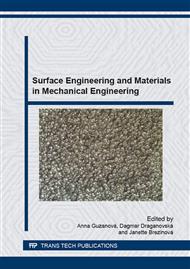p.121
p.125
p.129
p.133
p.137
p.141
p.145
p.149
p.153
Release of Metals from Cans during Short-Term Storage
Abstract:
Nowadays, cans are used widely to store and keep safely juices, drinks and liquid products with different taste. Especially in food industry one has to consider the effects of the content of inner side of the can due to the fact that some of the liquids can be very aggressive to the metals and surface treatment. The subject of this paper was to investigate the run-off-effect of metals from can into the solutions and analyze the data retrieved by Electrochemical Impedance Spectroscopy (EIS) and Linear Voltammetry (LV) techniques. We have observed phenomenon that release of metals is not only time but also temperature dependent. We have built equivalent circuits models for various conditions for both aluminum and tin cans. The aim of the project was to calculate “run-off” effect of Al and Sn from cans into drink during short-term storage and compare it with WHO norm.
Info:
Periodical:
Pages:
137-140
Citation:
Online since:
May 2015
Authors:
Keywords:
Price:
Сopyright:
© 2015 Trans Tech Publications Ltd. All Rights Reserved
Share:
Citation:


